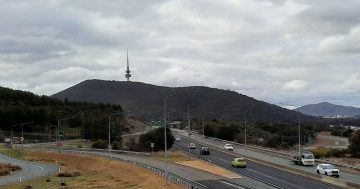
A stretch of the Tuggeranong Parkway will be part of Canberra’s first ‘smart road’. Photo: File.
One of Canberra’s most infamous thoroughfares will be the ACT’s first ”smart road” in a bid to reduce the number of crashes and the resulting gridlock.
The Tuggeranong Parkway between the Glenloch Interchange and the Cotter Road is notorious for peak-hour bottlenecks and collisions that can bring the major arterial road to a standstill, and choke other routes when traffic is diverted.
Painted chevrons on the road were introduced in 2019 in a bid to stop tail-gating and help drivers keep a reasonable distance between vehicles, but now the ACT Government plans to install a variable speed limit system like Victoria’s to manage traffic congestion, as well as reduce the likelihood of rear-end crashes along both carriageways, particularly northbound.
But the system, for now, won’t include the pinch points south of the Interchange where many accidents occur, covering the area from Lady Denman Drive (southbound) and Forest Drive (northbound) to the Cotter Road ramps.
If this project is successful, the system may be extended, especially with planned investigations into making Parkes Way safer.
An Intelligent Transport System tool will use traffic detection and other technologies to determine and display speed limits appropriate for road and weather conditions and traffic volumes.
This will involve electronic Variable Message Signs (VMS), Integrated Speed and Lane Use Signs and CCTV cameras, some mounted on gantries.
According to tender documents for the $1.5 to $1.7 million project, the smart system, which will base its decisions on a range of data it will continually collect, will be monitored and controlled remotely by TCCS’s traffic management centre.
The current speed limit for that stretch of the Parkway is 100km/h, but the new system could reduce speeds by 20 to 30km/h depending on the conditions or as low as 40 km/h if, for example, there is an accident.
The system will also provide estimated travel times and delays, detect accidents in real-time and alert motorists to trouble ahead and close lanes.
The government expects to sign a contract in the next couple of months, with work underway from April to July followed by testing and commissioning.
The system should be operating by the end of the year.
Tuggeranong Parkway carries about 35,000 vehicles per day, with about 3,500 to 4,000 vehicles in peak hour traffic.















